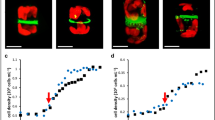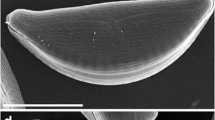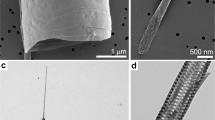Summary
Valve formation in a centric diatom,Chaetoceros rostratum Lauder is described. Following cytokinesis, an intracellular cytoplasmic strand traversed by mitochondria and microtubules remains between the sibling cells. The primary silicification site in the new cells is the eccentrically located labiate process area. A cytoplasmic labiate process apparatus is closely associated with labiate process formation. Silicification of the intercellular cytoplasmic strand results in firm intercellular linkage and division of elongated mitochondria. At intermediate developing stages, the valve has an unusual diagonal symmetry. The seta is the last valve component to be formed. Microtubules and a hitherto undescribed structure, the “striated dense body”, are involved in seta formation.
Similar content being viewed by others
References
Blank, G. S., Sullivan, C. W., 1980: Control of silicic acid metabolism, silica valve symmetry and pattern formation during synchronized growth of the diatomNavicula pelliculosa. J. Phycol.16, 5 a, abstract.
Chiappino, M. L., Volcani, B. E., 1977: Studies on the biochemistry and fine structure of silica shell formation in diatoms. VII. Sequential cell wall development in the pennateNavicula pelliculosa. Protoplasma93, 205–221.
Coombs, J., Lauritis, J. A., Darley, W. M., Volcani, B. E., 1968: Studies on the biochemistry and fine structure of silica shell formation in diatoms. V. Effects of colchicine on wall formation inNavicula pelliculosa (Bréb.) Hilse. Z. Pflanzenphysiol.59, 124–152.
Evensen, D. L., Hasle, G. R., 1975: The morphology of someChaetoceros (Bacillariophyceae) species as seen in electron microscopes. Nova Hedwigia, Beih.53, 153–184.
Fryxell, G. A., 1978: Chain-forming diatoms: three species ofChaetoceraceae. J. Phycol.14, 62–71.
—,Medlin, L. K., 1981: Chain-forming diatoms: evidence of parallel evolution inChaetoceros. Cryptogamie: Algologie, II,1, 3–29.
Hasle, G. R., 1974: The “mucilage pore” of pennate diatoms. Nova Hedwigia, Beih.45, 167–186.
Hoffmann, H.-P., Avers, C. J., 1973: Mitochondrion of yeast: ultrastructural evidence for one giant, branched organelle per cell. Science181, 749–751.
Hoops, H. J., Floyd, G. L., 1979: Ultrastructure of the centric diatomCyclotella meneghiniana: vegetative cell and auxospore development. Phycologia18, 424–435.
Iyengar, M. O. P., Subrahmanyan, R., 1944: On the structure and development of the spines or setae of some centric diatoms. Proc. nat. Acad. Sci. India14, 114–124.
Kato, K. H., Ishikawa, M., 1982: Flagellum formation and centriolar behavior during spermatogenesis of the sea urchin,Hemicentrotus pulcherrimus. Acta Embryol. Morph. Exper. n. s.3, 49–66.
Kolb-Bachofen, V., Vogell, W., 1975: Mitochondrial proliferation in synchronized cells ofTetrahymena pyriformis: a morphometric study by electron microscopy on the biogenesis of mitochondria during the cell cycle. Exp. Cell Res.94, 95–105.
Lafontaine, J. G., Allard, C., 1964: A light and electron microscope study of the morphological changes induced in rat liver cells by the azodye 2-Me-DAB. J. Cell Biol.22, 143–172.
Li, C.-W., Volcani, B. E., 1984: Aspects of silicification in wall morphogenesis of diatoms. Phil. Trans. R. Soc. Lond. B,304, 519–528.
— —, 1985: Studies on the biochemistry and fine structure of silica shell formation in diatoms. VIII. Morphogenesis of the cell wall in a centric diatom,Ditylum brightwellii. Protoplasma124, 10–29.
Mann, D. G., 1981: A note on valve formation and homology in the diatom genusCymbella. Ann. Bot. (Lond.)47, 267–269.
—, 1982: Structure, life history and systematics ofRhoicosphenia (Bacillariophyta). I. The vegetative cell ofRh. curvata. J. Phycol.18, 162–176.
McLachlan, J., 1973: Growth media-marine. In: Handbook of phycological methods and growth measurements (Stein, J. R., ed.), pp. 25–51. Cambridge: University Press.
Peragallo, H., 1907: Sur la division cellulaire duBiddulphia mobiliensis. Soc. sci. d'Arcachon Stat. Biol. Trav. des lab.10, 1–26.
Pickett-Heaps, J. D., Tippit, D. H., Andreozzi, J. A., 1979: Cell division in the pennate diatomPinnularia. IV. Valve morphogenesis. Biol. Cellulaire35, 199–203.
—,Kowalski, S. E., 1981: Valve morphogenesis and the microtubule center of the diatomHantzschia amphioxys. Europ. J. Cell Biol.25, 150–170.
Posakony, J. W., England, J. M., Attardi, G., 1977: Mitochondrial growth and division during the cell cycle in HeLa cells. J. Cell Biol.74, 468–491.
Reynolds, E. S., 1963: The use of lead citrate at high pH as an electron-opaque stain in electron microscopy. J. Cell Biol.17, 208–212.
Reimann, B., 1960: Bildung, Bau und Zusammenhang der Bacillariophyceenschalen (elektronenmikroskopische Untersuchungen). Nova Hedwigia2, 349–373.
Schmid, A. M., 1979 a: The development of structure in the shells of diatoms. Nova Hedwigia, Beih.64, 219–236.
—, 1979 b: Wall morphogenesis in diatoms: the role of microtubules during pattern formation. Europ. J. Cell Biol.20, 125.
—, 1980: Valve morphogenesis in diatoms: a pattern-related filamentous system in pennates and the effect of APM, colchicine and osmotic pressure. Nova Hedwigia33, 811–847.
—,Schulz, D., 1979: Wall morphogenesis in diatoms: deposition of silica by cytoplasmic vesicles. Protoplasma100, 267–288.
—,Borowitzka, M. A., Volcani, B. E., 1981: Morphogenesis and biochemistry of diatom cell walls. In: Cytomorphogenesis in plants (Cell Biology Monographs, Vol. 8,Kiermayer, O., ed., pp. 63–97). Wien-New York: Springer.
Schnepf, E., Deichgräber, G., Drebes, G., 1980: Morphogenetic process inAttheya decora (Bacillariophyceae, Biddulphiineae). Plant Syst. Evol.135, 265–277.
Schulz, D., Wedemeyer, G., 1981: Colchicine effects on diatom cell-wall morphogenesis. In: Proceedings of the sixth symposium on recent and fossil diatoms (Ross, R., ed.), pp. 457–475. Koenigstein: Otto Koeltz Science Publishers.
Spurr, A. R., 1969: A low-viscosity epoxy resin embedding medium for electron microscopy. J. Ultrastruct. Res.26, 31–43.
Tippit, D. H., Pickett-Heaps, J. D., 1977: Mitosis in the pennate diatomSurirella ovalis. J. Cell Biol.73, 705–727.
Author information
Authors and Affiliations
Rights and permissions
About this article
Cite this article
Li, C.W., Volcani, B.E. Studies on the biochemistry and fine structure of silica shell formation in diatoms. Protoplasma 124, 30–41 (1985). https://doi.org/10.1007/BF01279721
Received:
Accepted:
Issue Date:
DOI: https://doi.org/10.1007/BF01279721




